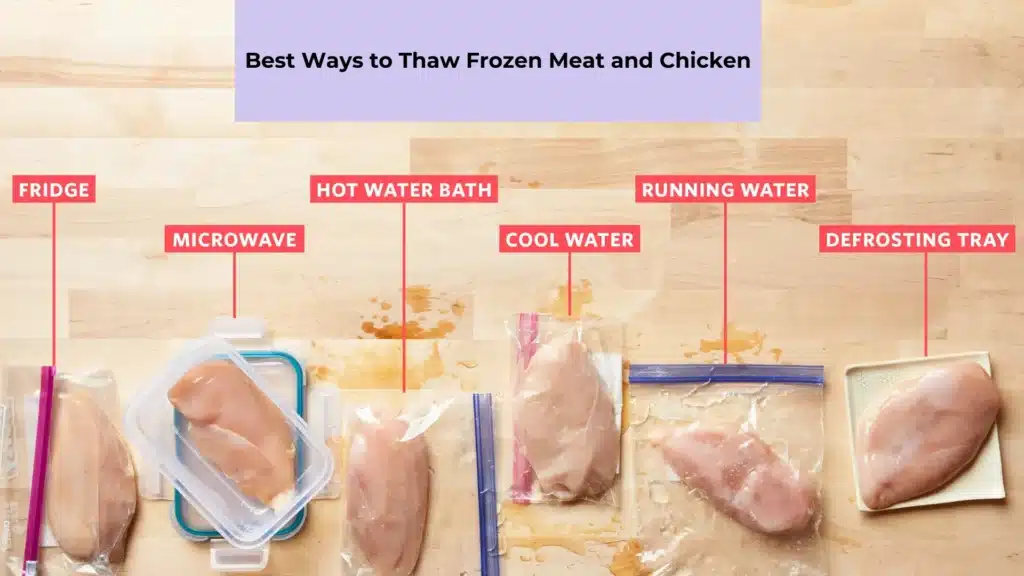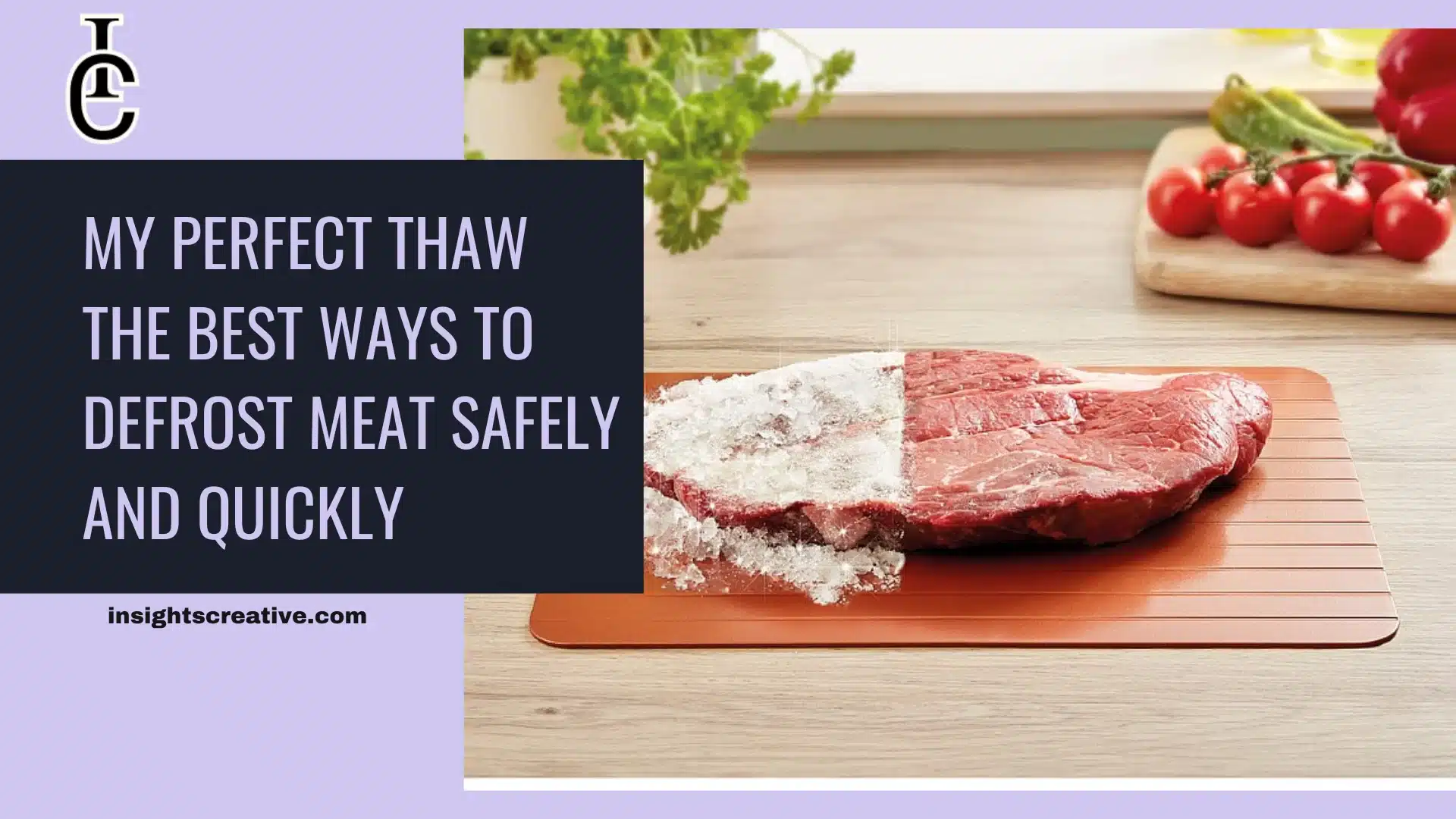When it comes to preparing dinner, sometimes you forget to take the meat out of the freezer ahead of time. That’s where knowing how to defrost meat fast can save the day. Whether it’s chicken, beef, or pork, using the right defrosting methods ensures the food remains safe to eat while maintaining quality. My perfect thaw involves using techniques that balance speed with safety, ensuring the texture and taste remain top-notch. Let’s dive into the various ways to defrost meat and explore the best practices for achieving quick and safe results.
Why Proper Thawing is Important
Proper thawing isn’t just about convenience; it’s also about food safety. Frozen meat, when left to thaw at room temperature, can quickly enter the “danger zone,” where harmful bacteria grow. This is why knowing the correct way to defrost meat, whether it’s chicken or beef, is essential. In this article, we’ll explore the best ways to thaw frozen meat and provide clear steps to ensure your meals are not only delicious but safe.
Best Ways to Thaw Frozen Meat and Chicken
1. Refrigerator Thawing: The Safest Option
When you have time, thawing meat in the refrigerator is the best method. This slow, controlled process keeps the temperature low, reducing the risk of bacterial growth.
- How to do it:
- Place the frozen meat on a plate or in a container to catch any drips.
- Put the meat in the fridge, ideally at a temperature below 40°F.
- Allow 24 hours for every 5 pounds of meat.
This method is perfect if you have a day or two to plan your meal, making it ideal for thawing a large roast or chicken.
2. Cold Water Thawing: Quick and Effective
When you’re short on time but still want to thaw meat quickly, the cold water method is effective and safe. It significantly reduces thawing time compared to using the fridge while maintaining food safety.
- How to do it:
- Submerge the meat in cold water, ensuring it’s in a sealed, leak-proof bag.
- Change the water every 30 minutes to keep it cold.
- Depending on the size, meat can thaw within an hour or a little more.
This method works great for chicken breasts or steaks, allowing you to thaw meat for dinner in under two hours.
3. Microwave Thawing: Fastest but Requires Care
If you need to defrost meat in a hurry, using the microwave is your fastest option. However, this method comes with risks, as parts of the meat can begin to cook, which may affect the texture.
- How to do it:
- Place the meat on a microwave-safe dish.
- Set the microwave to defrost mode, checking every few minutes.
- Rotate and flip the meat to ensure even thawing.
Be cautious when using the microwave, especially with delicate cuts like chicken, to avoid partially cooking the meat. Once thawed, cook the meat immediately to ensure safety.

Thawing Techniques for Different Meats
Thawing Chicken: Best Practices for Poultry
Knowing the best way to thaw chicken is crucial for food safety. Whether it’s a whole bird or chicken breasts, poultry is particularly susceptible to bacteria if not defrosted correctly.
- For a whole chicken:
- In the fridge: Allow 24 hours for every 4-5 pounds.
- In cold water: Expect 2-3 hours for a small chicken.
- For chicken breasts:
- In the fridge: It typically takes about 24 hours.
- In cold water: Chicken breasts can thaw in about 1-2 hours.
Thawing Beef: Quick Solutions for Busy Days
Beef can be tricky to thaw, especially if you’re working with large cuts like roasts or steaks. But with the right approach, you can defrost frozen beef quickly and safely.
- For steaks and ground beef:
- Cold water: Steaks and ground beef can thaw in under an hour.
- Microwave: It’s possible to defrost ground beef in under 10 minutes, but always cook immediately afterward.
- For large roasts:
- Cold water: Depending on size, a roast can take 2-3 hours in cold water.
- Fridge: Large roasts may require up to 48 hours to thaw fully.
Avoiding Common Thawing Mistakes
Don’t Use Hot Water to Thaw Meat
One of the most common mistakes people make is trying to thaw meat using hot water. While it may seem like a faster solution, hot water can cause the meat’s outer layers to heat up too quickly, creating a breeding ground for bacteria.
Avoid Thawing at Room Temperature
Leaving meat out on the counter is another common mistake. Room temperature is prime for bacteria growth, and leaving meat out for more than two hours can cause it to enter the “danger zone” (40°F to 140°F), where bacteria multiply rapidly.
How Long Does it Take to Thaw Meat?
The time it takes to thaw meat varies depending on the method and the size of the cut. Below are some general guidelines:
- Refrigerator thawing:
- Chicken breasts: 24 hours
- Ground beef: 24 hours
- Whole chicken: 1-2 days
- Large roasts: 2-3 days
- Cold water thawing:
- Chicken breasts: 1-2 hours
- Ground beef: 1 hour
- Whole chicken: 2-3 hours
- Steaks: 30-60 minutes
- Microwave thawing:
- Chicken breasts: 10-15 minutes
- Ground beef: 8-10 minutes
- Steaks: 8-12 minutes
Can you Thaw Frozen Fruits
Thawing frozen fruits like peaches is a quick and easy process that allows you to enjoy their natural sweetness anytime. For best results, thaw them in the refrigerator overnight to maintain their texture and flavor. If you’re short on time, you can thaw them at room temperature for a couple of hours or submerge them in cold water for about 30 minutes. For a super quick option, use the microwave’s defrost setting, but be cautious to prevent them from becoming too soft. Once thawed, peaches are perfect for baking, smoothies, or enjoying as a snack
Conclusion: Finding Your Perfect Thaw
Thawing meat doesn’t have to be stressful or time-consuming if you know the right techniques. Whether you use the fridge, cold water, or the microwave, each method has its benefits, depending on how much time you have. My perfect thaw combines safety and efficiency, ensuring that your meal preparation is seamless and stress-free.







